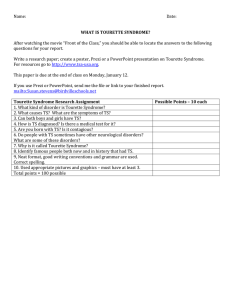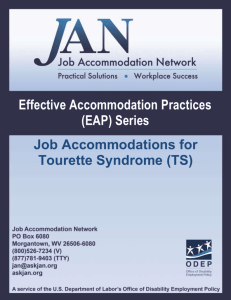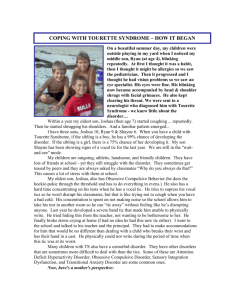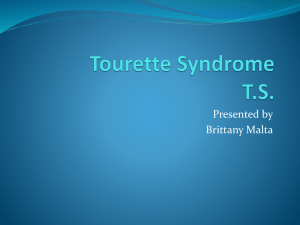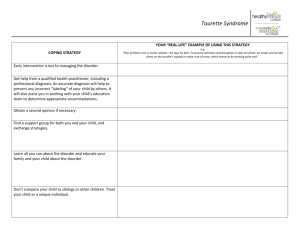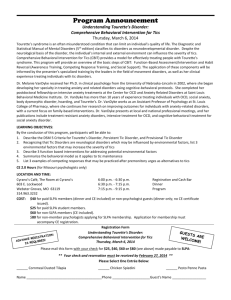TSA YOUTH AMBASSADOR PROGRAM - Tourette Association of
advertisement
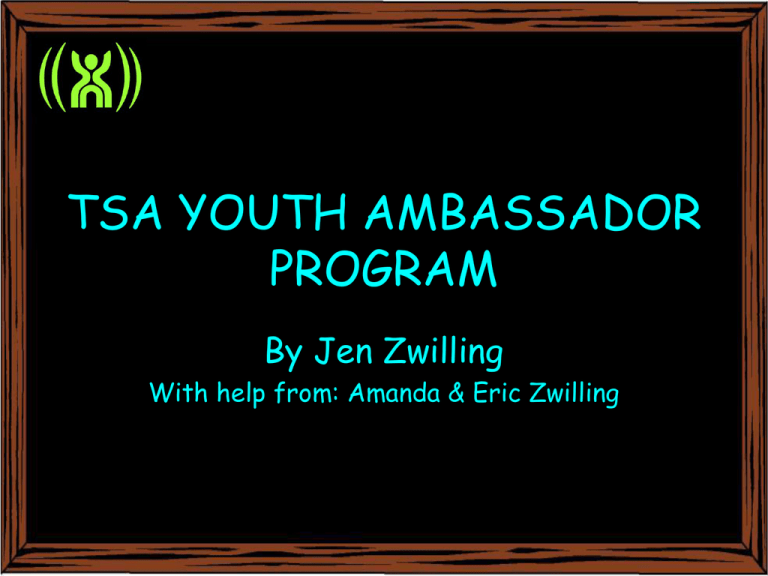
TSA YOUTH AMBASSADOR PROGRAM By Jen Zwilling With help from: Amanda & Eric Zwilling How Can We Help Others Deal With Tourette Syndrome? • One of the most important things that you can do for children with TS is to educate their peers and the people who they encounter each day about their disorder. • There are many ways of doing this. • One of the most effective ways is to have their peers or teenagers whom they feel they can relate to, be the ones to teach them. • Following is an outline for students to follow when presenting this information to a group. • Obviously, the vocabulary and amount of information will differ depending on the grade level that is being informed. • It is important that all key points are covered, although as a presenter you will have to have the ability to lead your presentation in a way that fits the group’s attention span and maturity level. • In order to do this presentation, you will need to be trained so that you can be very informed and familiar with accurate information so that you can be prepared to answer questions and discuss issues accurately. • Therefore, all presenters must know the information and be able to explain and discuss all the facts and information that are in the Educator’s In-Service Program on Tourette Syndrome pages 4-7 and pages 14 and 15. • In addition, presenters should be familiar with pages 25-27 of the Participant’s Guide. • You will need some visual aids for this presentation. They should be large, colorful, bright and eye-catching! (Examples will be provided during training) • A poster or tri-fold with a large heading that says TOURETTE SYNDROME with the following definitions should be used: • Since “tic” is going to be a major concept you should have a big card that says: • -Tic• An involuntary, sudden rapid, recurrent, nonrhythmic, stereotyped motor or vocal involvement….. • Of course you will now have to explain this! So have another card or place on the poster where it says • -Tic• A movement or sound that your body makes that someone cannot control • (At the appropriate time you will give examples) • The poster should also include large facts such as: • -TS is hereditary. This means that people with TS are born with it just like you are born with blonde hair or blue eyes. • -TS is not contagious. • -People with TS do not choose to have it, and they have not done anything bad or wrong to cause them to get it. • -We should not make fun, or treat anybody differently just because they have TS. They are as normal as you and me! • The poster should also include the National TSA ads with kids and adults that have TS. • Have a separate poster with the quote • “WHY DO I ACT THIS WAY? • Because I can’t control it-I have Tourette Syndrome-a medical condition. It causes me to make loud sounds, have twitches, and say things I don’t mean. I can’t help it anymore than you can stop a sneeze or a cough. I am sorry if it bothers you—it bothers me more.” • (You will not display this right now; you will bring it out at the end when the presentation calls for it!) • You will also need enough paper, pencils and copies of the Pledge of Allegiance to hand out to everyone in the group. • Set up your posters or tri-fold (except for “Why Do I Act This Way?) and have all your supplies ready before beginning. Now you are ready to begin! PRESENTATION • Start out by introducing yourself. If you are working with a small group ask each child their name so that they begin to feel comfortable talking with you. • Inform the group that you are from an organization called the Tourette Syndrome Association and you are here to talk about Tourette Syndrome. • Next, ask the children if anyone has ever heard of TS. If children have heard about it let them explain what they know. • Be prepared to hear answers that are not factual, especially things they have seen or heard in the media. If answers should come up like these explain that that is how Tourette is shown in the media, but they are going to soon find out how different Tourette really is. • Remember to give positive reinforcement, even if an answer is wrong. You want to make the kids feel confident in contributing to the conversation. • Now, tell the group that you are going to switch topics for a second. Bring up other, more common medical conditions that the children probably have heard of. (Examples: asthma, juvenile diabetes) • Ask them if they know anyone who has these or anything about these medical disorders. • Most children will know about asthma so lean the conversation towards that. • Ask the group if they would ever make fun of someone for having to use an inhaler, or for having an asthma attack. • Point out that they would not because the child would not be able to control what they were doing. • Point out that the child did not do anything wrong to get asthma, and therefore it is not his fault. • Go back to Tourette Syndrome • Explain how Tourette Syndrome is the same sort of thing. • It is something that someone’s body does that they did not do anything wrong to get. • State that that is why you would not make fun of someone with Tourette either. • Now, if you or another presenter has TS, you can now point that out to the group and tell them who does have it. • Then ask the group if they have noticed anything that the person is doing that seems a little different. • This should lead into a conversation on tics. • Introduce the term tic and explain that it is the name for the movements or sounds that they might have noticed. • Clarify the difference between a tick (the bug) and a tic. • State that a tic, like a twitch, is an involuntary, sudden rapid, recurrent, non-rhythmic, stereotyped motor involvement or vocalization. • It is important to first give this definition and then explain in simpler terms • A tic is a sound or movement a body makes that a person does not have control over. • Explain that a tic is like the urge to sneeze, or the urge to scratch an itch. • Make these comparisons to show how a person does not decide when they sneeze, or when they get an itch. • Also mention how if you try to put off an itch, it takes a lot of energy and it becomes all that you can focus on. • Say that this is the same as trying to hold in those movements or sounds. • Explain the difference between motor and vocal tics and point out that for someone to be diagnosed they must show at least one of each type for at least one year. • Give the group examples of different common tics. • If they had brought up coprolalia, then explain how uncommon that actually is. Talk about how the media just finds that amusing and that is why it is commonly shown. • Explain that many people have tics from time to time and that they don’t last for a year or more. • Explain that some people just have a tic and that does not mean that they have TS. (But any tic that continues for some time should be brought to the attention of your physician.) • Explain that TS is something that you are born with and that you have it for your entire life just like the color of your hair or eyes. • Now state that Tourette is NOT contagious. You cannot catch it from anyone. • People who have Tourette are born with it, even though symptoms do not normally show until in-between the ages of five and seven. • Again, emphasize that people who have Tourette did not do anything wrong to get it. • Explain that no one knows the exact cause of Tourette syndrome, but it is known that it is a disorder that is inherited. • This can lead into a conversation on genetics and how Tourette, just like having blonde hair, or blue eyes, is hereditary. • Explain that this term means that it is passed down through someone’s genetic makeup. • A good way to start this conversation is to ask how many people have ever been told they look like their mom or dad. • Engage the group and ask what other traits they have inherited. • Bring up the need for glasses. • If a child brings up their own glasses ask if anyone else in their family has to wear glasses. • Explain that this is an example of things getting passed down from parents, grandparents, or even generations before that. • Ask the group how much control we have on the things that we inherit from our parents. • Now tell the group that almost everyone has something that they got from their parents that they would like to change about themselves. • A presenter can give an example of rather having straight or curly hair, being too tall or too short, or the color of their eyes. • Now ask the group if it is fair to make fun of anyone for something that they do not have control over? • To sum everything up, state that TS is a disorder that people inherit that causes them have verbal and motor tics. • People have TS for their entire life. There is no cure for TS. • Some people take medications that control some aspects of their TS, but these medications do not cure the TS. • TS is not contagious, nor can you die from it. • People have no control over if they have TS or not, and no one does something that causes them to have it. • Now ask the class-- if TS is not contagious and you cannot die from it than what do you think may be so bad about having TS. • Make sure to touch on the following things. • Tics can be embarrassing. Just when a person with TS may think they have their tics under control, other tics can come too. Tics change. • Some people have the same tics for a very long time (years). • But you can also have tics for a short while and they go away and then you can get different ones. • Tics can be very noticeable and people are sometimes rude and make fun of people. • This is because they don’t understand. • Explain that by learning what TS is, they are helping a lot of people, just by understanding. • You may want to bring up stories of your own if you or someone presenting has TS. • Some tics are not very noticeable at all. But, these tics can often cause your body to hurt. Imagine if a muscle in your arm was tightening all day, all the time. Explain how this would cause your muscle to feel sore. • Tics can also interfere with things that you might want to do. If you are constantly moving your head, or blinking your eyes, it would make it very hard to do simple things like read, watch TV, or copy something from a blackboard. • People also have tics of the mind. If your audience is old enough, you can talk about how it is the same sort of thing as having OCD. • Give examples such as your mind tricking you into thinking that you must erase things if they don’t look perfect on a piece of paper. • You can explain that sometimes kids feel that they must count things over and over again. • Explain that if you get a thought in your head and you can’t make it go away how hard it would be to pay attention or listen to the teacher in school. • At this point you tell the group that you are now going to give them the experience of having Tourette for a little while. Distribute paper, pencils and a copy of the Pledge of Allegiance. ** Remind the group that having TS can make doing simple things difficult. ** • Explain that you will be giving them two tics. • The first tic will be touching their pinky finger, on the hand that they are writing with, to the desk. • Explain that every time you clap, they will need to tic. • The next tic they will have will be more like a tic of the mind. • Every third word they write they will need to erase, and then rewrite. • Tell the group that you are giving them 90 seconds to write the pledge, neatness is being counted, and that they are being graded. Put them in a situation in which they would feel pressured. • Walk around the classroom and look over students’ shoulders. • Clap very often. • When the 90 seconds is up ask to see by a raise of hands who finished. • Most likely no one will have. • Ask the group to describe how they felt and what made the task difficult. • Let the group talk about this for a while because this exercise normally leaves a very big impression on the students. • **For students in Kindergarten, 1st and 2nd grades this activity should be modified. Do not distribute the Pledge-- Simply have the children try to write their names while blinking their eyes and nodding their heads “yes”. • Now, remind them once again how a tic is an involuntary, sudden, rapid, recurrent movement that is either motor or vocal. • In order to have TS you must demonstrate one of each and that they only had a motor tic for this exercise, while most people with TS have multiple motor and verbal tics along with the tics of the mind. • Next explain that tics get worse when people feel stressed, anxious, excited, fatigued, or when not feeling well or getting sick. • Simple tasks in school that don’t normally make people feel nervous would make someone with TS anxious because of everything that the student just felt in the activity. • Now ask the group how now knowing what TS is how they can help people with TS. Lead the discussion towards tolerance and understanding people’s differences. • Make sure you touch on the following points. • -Never make fun of people over something that they cannot control • Now show the visual of the “why do I act this way” card • “WHY DO I ACT THIS WAY? Because I can’t control it- I have Tourette Syndrome- a medical condition. It causes me to make loud sounds, have twitches, and say things I don’t mean. I can’t help it anymore then you can stop a sneeze or a cough. I’m sorry if it bothers you—it bothers me more.” • Try to be understanding and patient towards others • Encourage others not to make fun of people and to stick up for the victim if they see teasing or bullying occurring • Lastly, remember that TS is not contagious, people don’t do anything wrong to get it, they are born with it, they have it for their entire life, there is no cure. • TS is just a little part of them amongst many other positive qualities. • People with TS are as normal as anyone else! • Ask if there are any questions and bring the presentation to an end. You should not rely on the information in these materials as a substitute for consultations with qualified health care professionals who are familiar with individual medical conditions and needs. TSA strongly recommends that care and treatment decisions related to Tourette Syndrome and any other medical condition be made in consultation with a patient's physician or other qualified health care professionals who are familiar with the specific individual's health situation.

